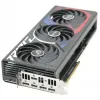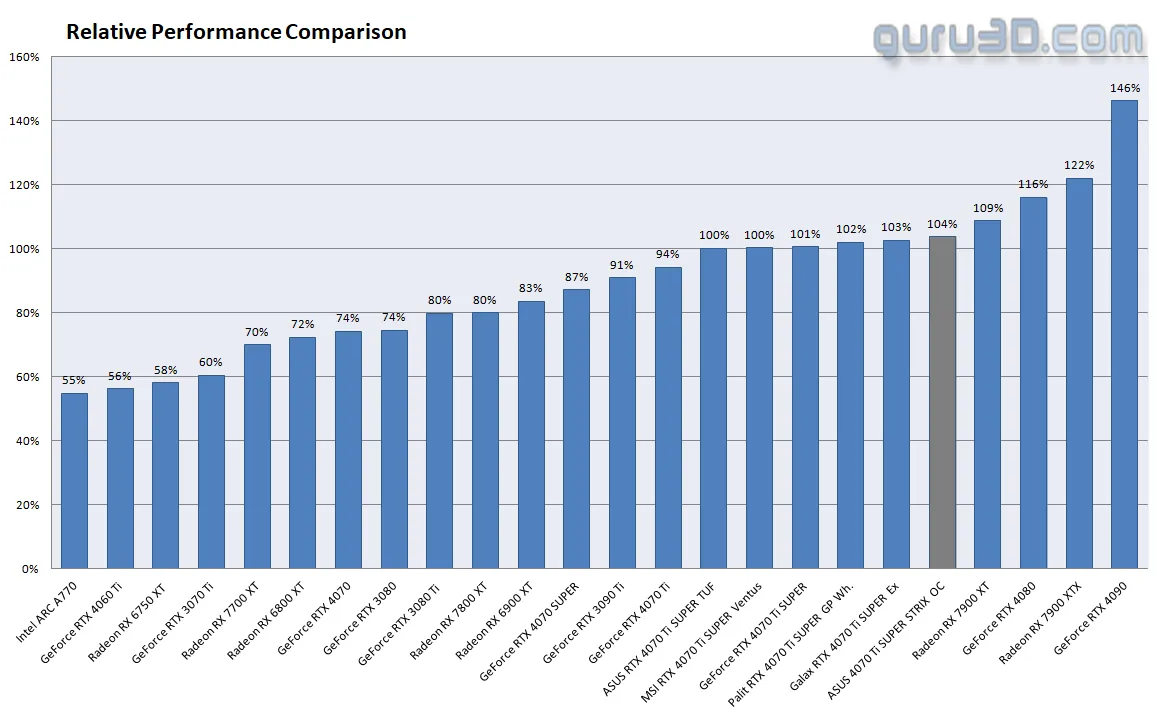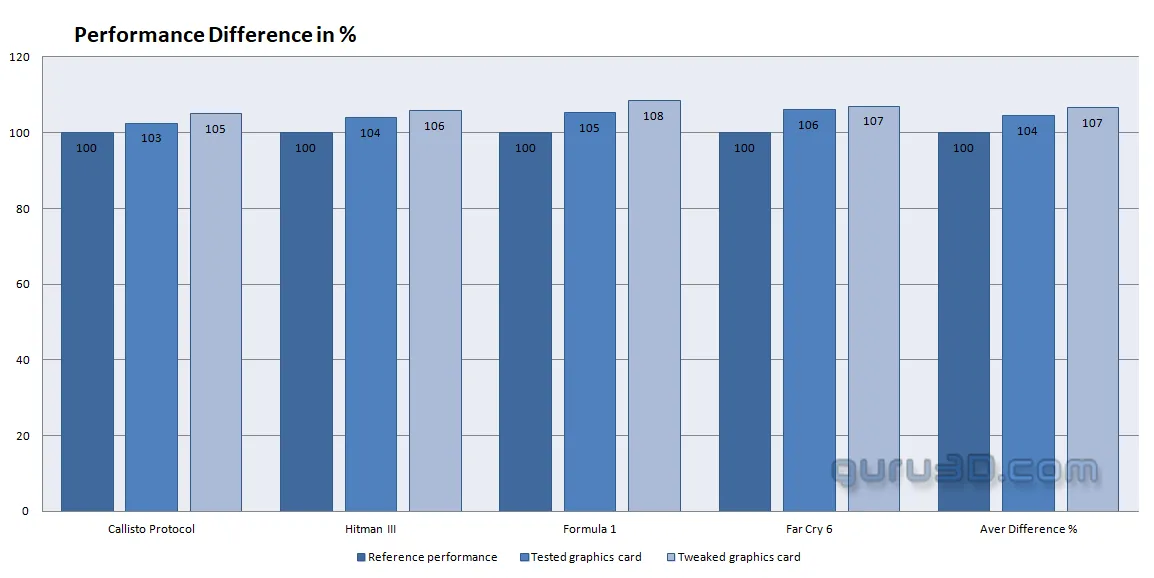Final words and conclusion
It has been some time since we last reviewed an ASUS STRIX product, which now features a new design approach. Adapting to its more artistic style required some adjustment on my part. It's important to remember that aesthetic preferences are subjective. Before delving deeper, I must highlight the notable size and weight of this item—almost 2 kg and roughly 34 cm. While this might not seem like a step forward, it's characteristic of this GPU's design. Combining these aspects results in a high-performance product. Notably, it operates at a quiet 33 dB in silent BIOS mode, and under performance load, it maintains a temperature well within 60-65 degrees Celsius, with a noise level of 36 dBa.
- CUDA Cores: 8448
- Memory: 16GB GDDR6X
- TGP: 285W
- Power Consumption: Approx. 226W during gameplay, 12W in idle
- Notable Feature: Enhanced memory for improved performance
When the original GeForce 4070 Ti was released we had a big remark, it's by far not as powerful as the 4080 with an offset of approximately 25%. This is now corrected with the SUPER edition of this card, as you're merely a few % away from that 4080. Its raw shader performance notably surpasses previous generation. The card also boasts significant advancements in ray tracing speed and capabilities. NVIDIA is increasingly leaning on DLSS3, with its enhanced Tensor cores supporting RT DLSS 3.5. NVIDIA anticipates a 3x to 4x performance boost in future titles with proper implementation, although there's ongoing debate about the actual benefits of frame injections beyond higher frame rates. Ultimately, the visual appeal on the monitor is key, and the 4070 Ti SUPER does not disappoint in this regard. High-end NVIDIA graphics cards, however, face two major challenges. Firstly, pricing is a significant barrier; with a starting price of $799, these cards remain unaffordable or unattainable for many. The increasing cost of PC gaming is driving consumers to seek alternative solutions. Secondly, the 12V power connector still raises concerns. The issue isn't the connector's safety, but rather the risk posed by bending the cable too close to the connector, especially if it's of poor quality. It's recommended to bend the cable 3-4cm from the connector and ensure it's securely and deeply plugged in. In our tests with all cards using FLIR imaging to check the connector level, we have not found any issues.
Performance
The data speaks for itself, the key factors here are gaming performance and rendering quality. Indeed, the RTX 4070 Ti SUPER offers better value for money compared to the 4080. This card is approaching the raw performance required for gaming at 4K resolution. It caters specifically to enthusiast gamers who typically use monitors with UWHD, QHD, or UHD resolutions, making it an ideal choice for that demographic. The rasterizer engine in the RTX 40 series significantly surpasses the performance capabilities of its predecessors. This series introduces a new generation of more potent Ray tracing and Tensor cores. Raw counts of RT and Tensor cores are not the sole indicators of performance; rather, the effectiveness of each unit is key. These cores are positioned near the shader engine, enhancing their efficiency, a fact that is evident in their performance. While Tensor cores' impact is more challenging to quantify, the impressive results observed, especially with DLSS3, indicate their robust performance. The GeForce RTX 4070 Ti demonstrates its strength across various resolutions, performing effectively from 2K (2560x1440) to 4K (3840x2160).
Cooling & noise levels
The graphics card, under full-load conditions, has a power consumption of 280 watts. This consumption is directly related to the heat generation of the GPU, which is located inside a sealed enclosure. In terms of noise, the card operates quietly, producing approximately 33 or 36 dBA depending on BIOS and GPU temperature preference. When subjected to stress, its temperature can rise to around 65°C, although this can vary depending on the airflow efficiency in the computer case. FLIR imaging does not indicate any thermal issues.
Energy consumption
In a previous chapter, we analyzed the GeForce RTX 4070 Ti SUPER power usage during intensive gaming sessions. This graphics card typically requires about 250-300 watts of power (Total Board Power) to deliver its gaming performance. However, during actual gameplay, the power consumption tends to stabilize near 275 watts. This figure will vary slightly with customized models from various manufacturers, which might allow for a higher Total Graphics Power (TGP).
Coil whine
The presence of coil squeal in any GeForce RTX 4070 Ti SUPER graphics card can vary, depending on the degree of the issue. It becomes audible when reaching high framerates, but typically remains at a manageable level. Within an enclosed case, this sound is likely to blend into the background noise. In our experience with this specific card, the coil squeal has been noticeable
Pricing
The suggested retail price for the NVIDIA GeForce RTX 4070 Ti SUPER, as set by the manufacturer, is $799 for the MSRP products. This price point is relatively high, especially when considering that the ideal cost for a graphics card should be lower than that of a current gaming console. Add-in Board (AIB) versions, which are more advanced, will often be priced higher. It is expected that these models will cost an extra $50-100. This product however is tagged close to MSRP, we expect something in the $849-899 range (after prices settled in a month or so).
Tweaking
By adjusting the clock frequency and memory speed of your GPU, you can achieve a performance improvement. We have been able to increase the power limiter by 28%, normally allowing for enhanced performance within the card's existing power budget. It didn't yield that much though. This enhancement enables an increase in clock frequency, typically in the range of ~200MHz. As a result, the GPU boost clock frequency is expected to reach approximately 3050-3075 MHz, though this may vary based on the dynamic frequencies in different gaming titles. Additionally, by adjusting the memory speed to 23 Gbps, a cumulative performance improvement of 7% can be expected in intensive GPU scenarios, in comparison to the standard reference performance.
Conclusion
The ASUS ROG Strix GeForce RTX 4070 Ti SUPER OC Edition graphics card stands out with its lovely aesthetic, marking a significant departure from the traditional look of previous ROG Strix models. Its eye-catching design is likely to draw attention. The performance of the STRIX series is noteworthy, yet the physical dimensions of this card might be a concern for some users. Measuring 34cm in length, weighing 1.8kg, and occupying 3 slots, it requires considerable space inside a PC. Despite its size, the card delivers impressive results with low temperatures, minimal noise, and high performance. However, a drawback is more coil whine compared to other brands we tested. Overall the GeForce RTX 4070 Ti SUPER delivers a robust gaming experience, and when comparing it directly to similar GPUs, it surpasses the performance range of the 3090 Ti and is close to the RTX 4080, with some variability. In a broader context, when comparing it to other GPUs like the Radeon RX 6950 XT and 7900 XT/XTX, a complex decision-making process ensues.The choice between the 4070 Ti SUPER and 7900 XTX hinges on several factors. The RTX 4070 Ti SUPER excels in ray tracing performance and boasts the added benefit of DLSS3/3.5 and at many levels is on par with more than 3090 cards. Looking at Team Red the 7900 XT exhibits a slight advantage in rasterizer engine performance, supported by its additional L3 cache. The 16GB of VRAM offered by the 4070 Ti SUPER is sufficient for most current titles, especially when playing at Ultra HD resolutions. Powered by the ADA GPU architecture, this card delivers precision and competence in gaming. The substantial increase in shader cores translates to nearly 1.5 times the raw shader performance, resulting in faster ray tracing and improved Tensor core performance. Underlying technologies such as Shader Execution Reordering (SER) and DLSS 3 contribute to the excellence of the new product and the Series 4000 overall. In conclusion, the GeForce RTX 4070 Ti SUPER leaves a notable impression and is sure to please gamers, but it comes at a considerable cost. Despite its commendable performance-per-watt ratio, its energy consumption levels remain relatively high. This graphics card is capable of handling Ultra HD gaming smoothly, particularly when enhanced with DLSS3 / Frame generation, and offers the possibility of a moderate overclock. The card boasts an appealing design and sufficient cooling performance, although its acoustics are fine they remain average compared to competitors.
The performance improvement over the baseline reference model is roughly 4%, it remains a robust graphics card for enthusiasts, offering significant power and the potential for mild overclocking, a bit of tweaking will get this card running at 107% compared to baseline reference performance.
The ASUS RTX 4070 Ti SUPER ROG Strix graphics card, aside from its premium pricing (we're still uncertain what final pricing will be), is a notable product. Its design adopts the modern and popular streaming colors of blue and red, giving it a sleek and contemporary appearance. The dimensions of the card are quite substantial, reaching the upper limits of compatibility with many cases, including mid-towers. Its design is well-rounded, though the card is notably heavy at 1.8kg, necessitating the use of the included stand for support. As part of the ROG Strix product line, this graphics card is well-equipped to handle a wide range of gaming challenges.
- Download NVIDIA GeForce drivers
- Sign up to receive a notification when we publish a new article.
- Or go back to Guru3D's front page
- Hilbert, LOAD"*",8,1.




